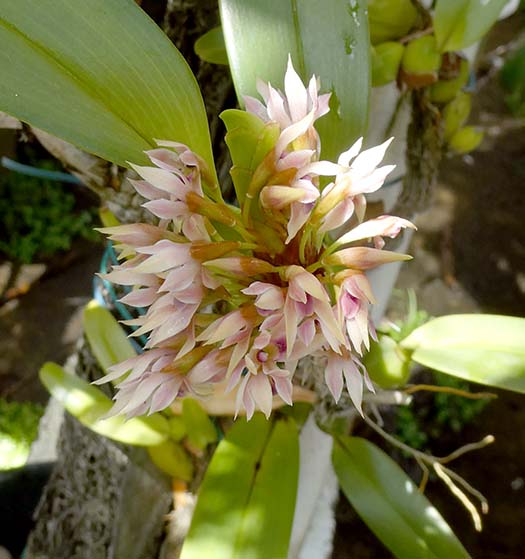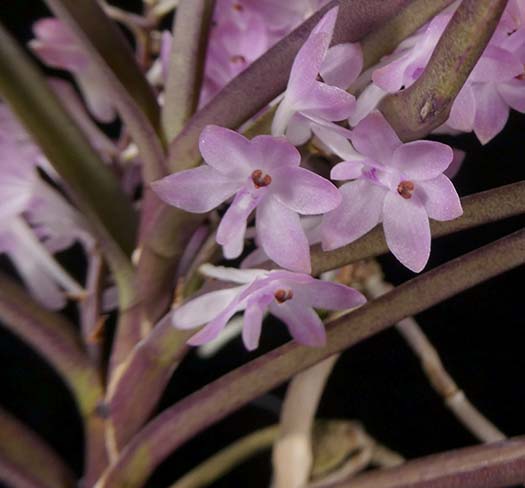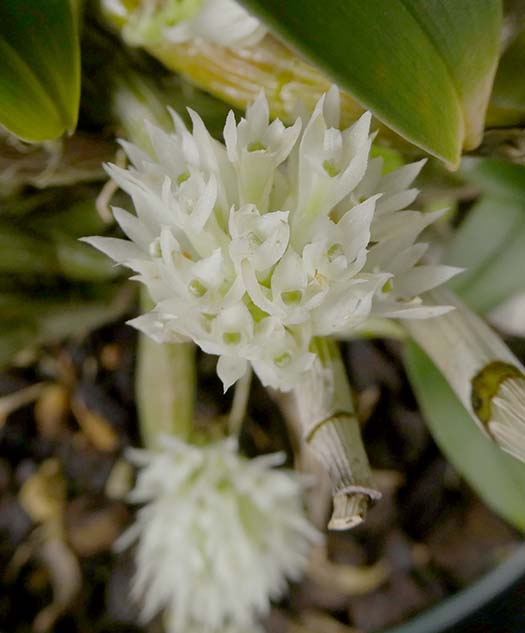May 2023
From Kurt Shanebeck:
|
|
Outdoors coastal, north of Los Angeles: |
|
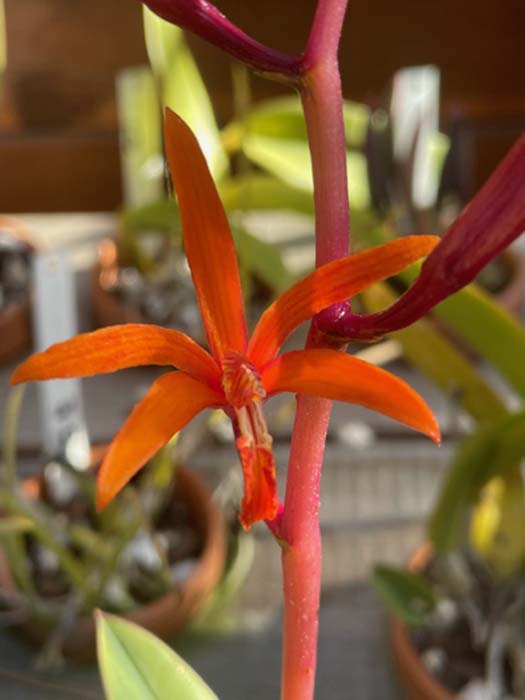
Cattleya neokautskyi (Laelia kautskyana)Yet another Brazilian rupicolous species |

Dendrobium falcorostrumAn Australian epiphytic species. Growing potted in a bark mix with bright light. |
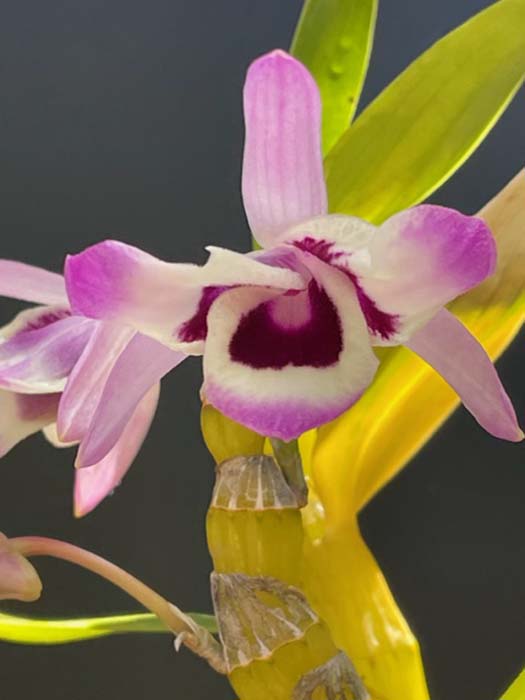
Dendrobium nobile var. CooksianumA peloric form of this species native to the Himalayas. Growing mounted with bright light. |
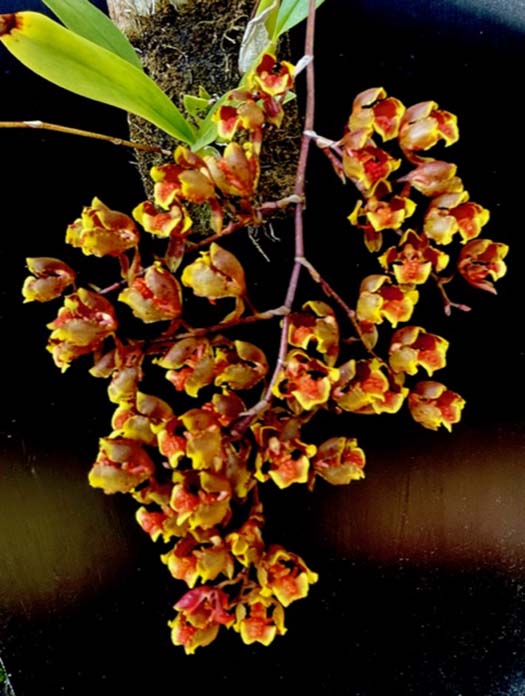
Gomesa (Oncidium) widgreniiEpiphyte from Brazil, growing mounted with moderately bright light. |
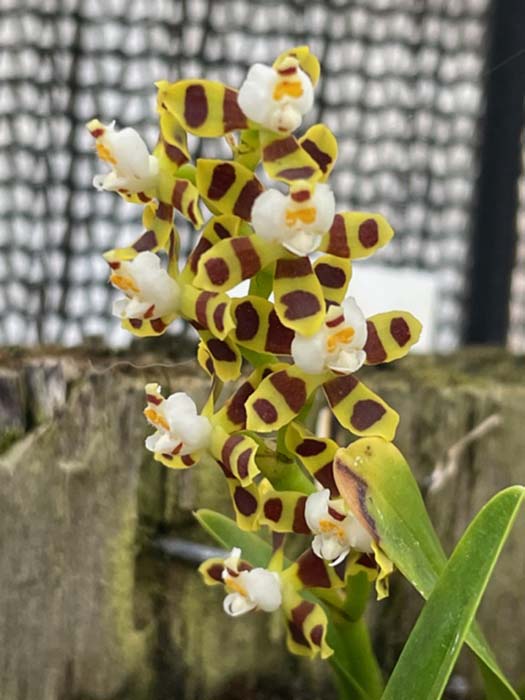
Oncidium (Solenidiopsis) tigroidesNative to Peru. A smaller plant, growing mounted and shady. |
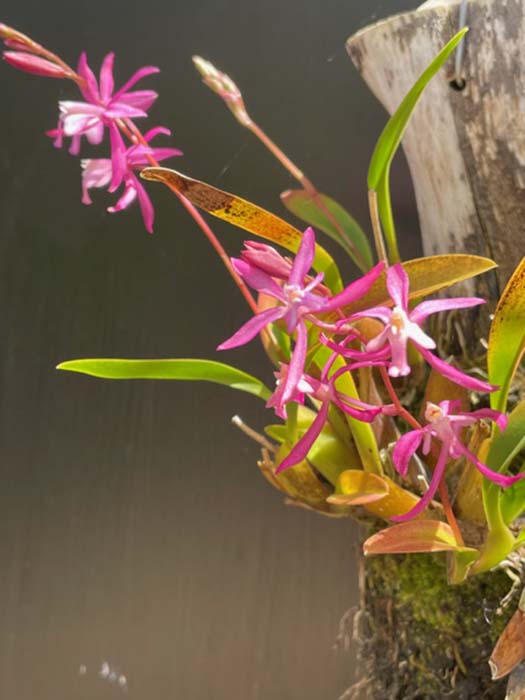
Oncidium (Cochlioda) vulcanicaNative to Columbia, Ecuador and Peru. Growing mounted with moderate light. |
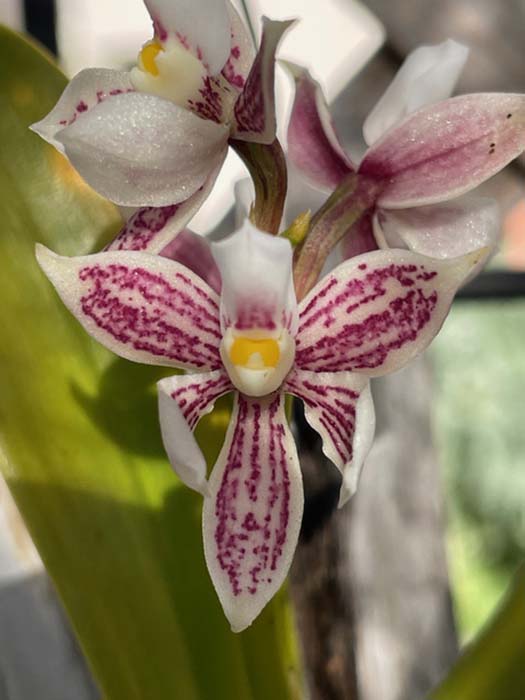
Prosthechea (Encyclia) faresianaA Brazilian species. Growing potted in moss with bright light. |
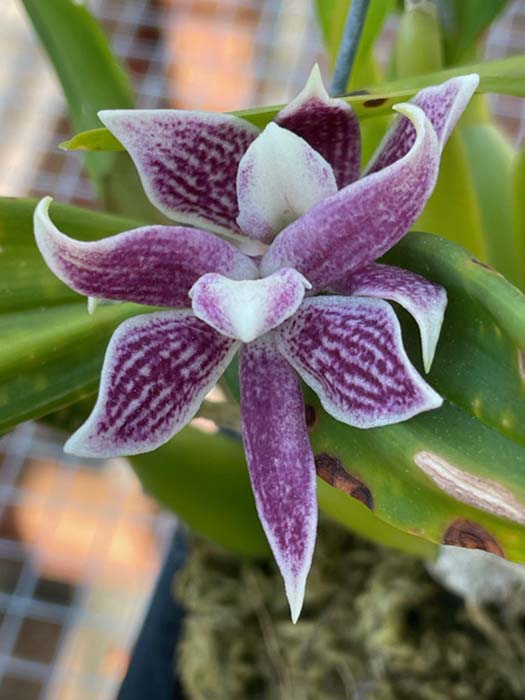
Prosthechea (Encyclia) garcianaA Venezuelan species, growing mounted with bright light. Long lasting flowers. |
From Chris Ehrler:
|
|
Coastal, California Central Coast |
|
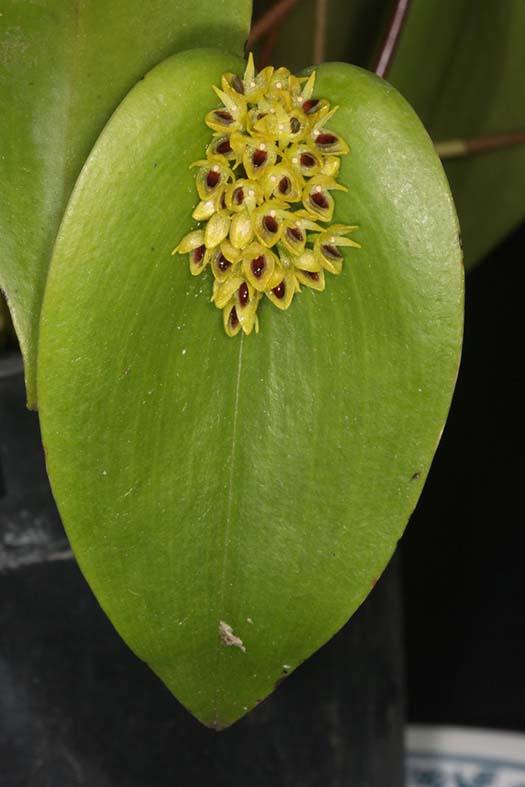 |
|
Pleurothallis canaligeraIs native to Colombia, Ecuador and Peru growing in a cool to cold environment as either an epiphyte or as a terrestrial. Growing in a cool greenhouse in a plastic pot filled with bark and lava rock. |
|
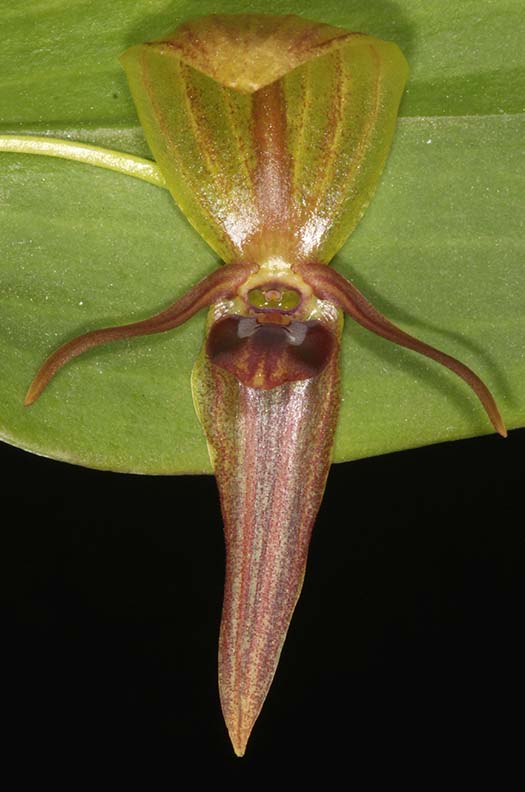
Pleurothallis grandiflora 'Gigi'A cool to cold growing epiphyte found natively in Venezuela, Colombia, Ecuador, Peru and Bolivia at elevations of 1100 to 3300 meters. This orchid is in a cool greenhouse and is growing in a clay pot filled with sphagnum moss.
|
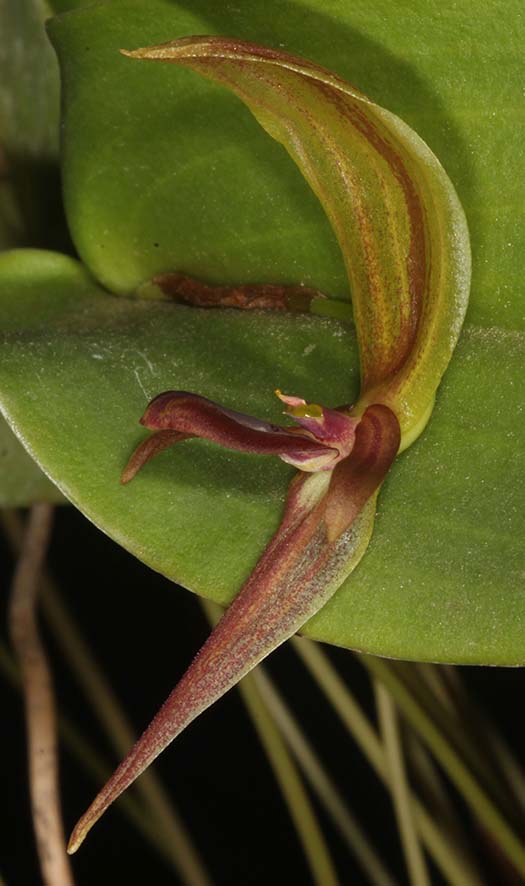 |
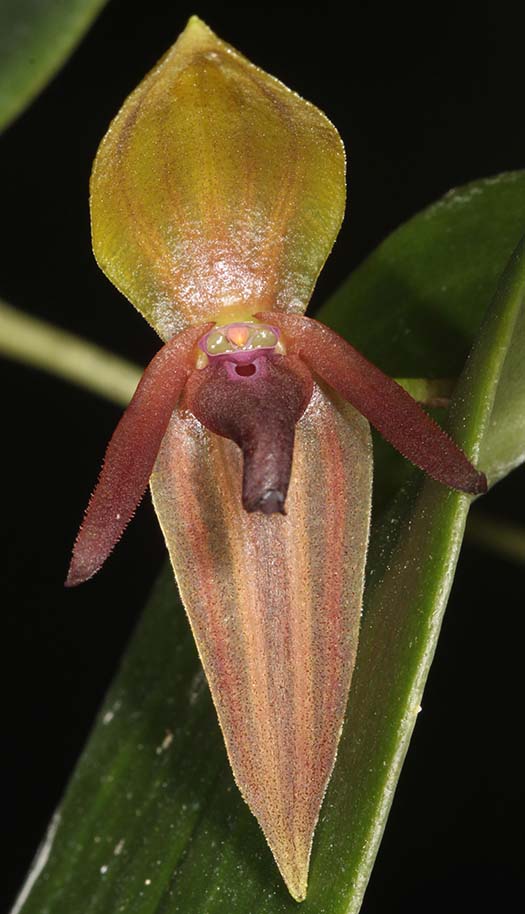 |
|
Pleurothallis linguiferaFound at elevations of 1,500 to 3,400 meters as a cold to cool growing epiphyte in Colombia, Ecuador, Peru, Bolivia, and Venezuela. This orchid is growing in a clay pot filled with sphagnum moss, with the pot in a cool greenhouse. |
|
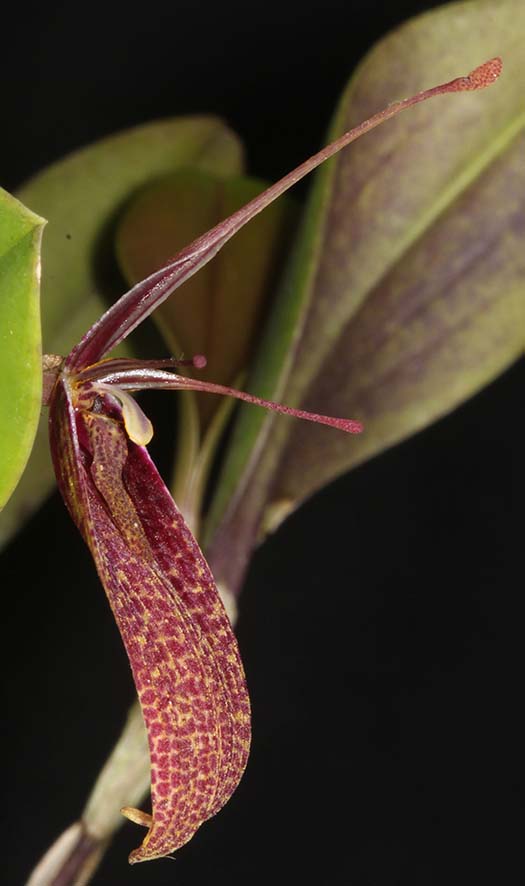
Restrepia guttulataThis is a division of an orchid collected near Atillo, Ecuador. Is native to Colombia, Ecuador, Peru, and Venezuela and is a cool to cold growing epiphytic species found at elevations of 1700 to 3000 meters. The purple coloration of the back of the leaf seen in the photo is normal. This orchid is growing in a clay pot filled with sphagnum moss which is in a cool greenhouse |
|
Pleurothallis bivalvis var. xanthinumA cool to cold growing epiphyte or terrestrial growing 1,000 to 3,300 meters in elevations from Mexico to Bolivia. This orchid almost always has open flowers throughout the year. Is growing on the north side of the house in a clay pot filled with bark and lava rock mixture. |
|
From Scott McGregor:All orchids grown outdoors, coastal southern California |
|
Orchis italicaThe “Italian man” orchid, widely distributed across the Mediterranean region. The flowers are scented like pink clover. |
|
Serapias cordigeraOne of the larger “tongue” orchids with a very dark, very hairy lip. |
|
Serapias linguaPerhaps the easiest of all the Mediterranean terrestrials to grow, I end up with about 2-3X the tubers at the end of the season and so grow them in “community pots” for better flower “drama”. Small, but cute. |
|
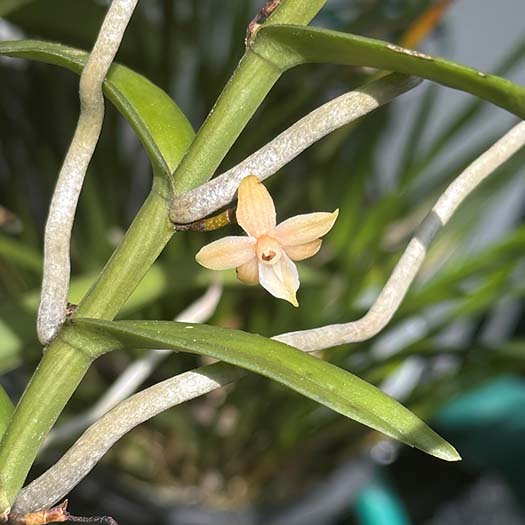
Angraecum erectumTiny (1cm) flowers along the vertical stem. Perhaps the “ugly duckling” of the genus in terms of flower size and ratio of plant size, but hey, it’s an Angraecum and it is easy to grow! I grow mine on a 2’ tree-fern pole and when growths get about 12” above the pole, I cut them off and tie them to the bottom of the pole where they quickly attach. |
|
From Roberta Fox:
|
|
Outside in the Back Yard: |
|
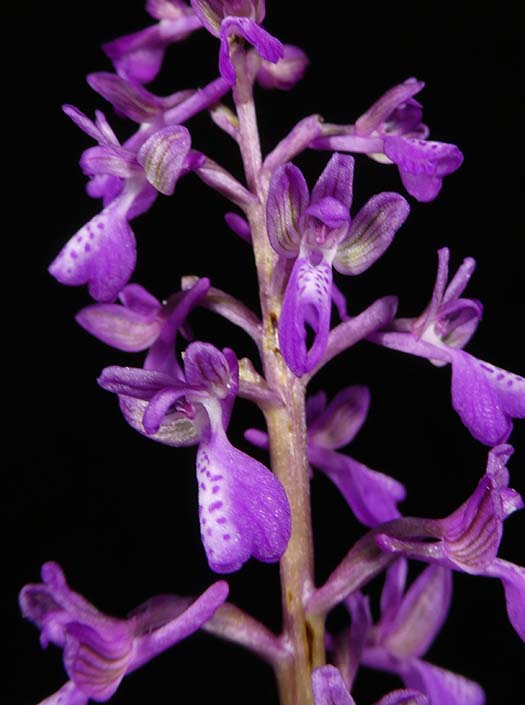 Anacamptis laxifloraEuropean and North African countries surrounding the Mediterranean, and as far north as Switzerland. A big month for Mediterranean-climate terrestrials |
|
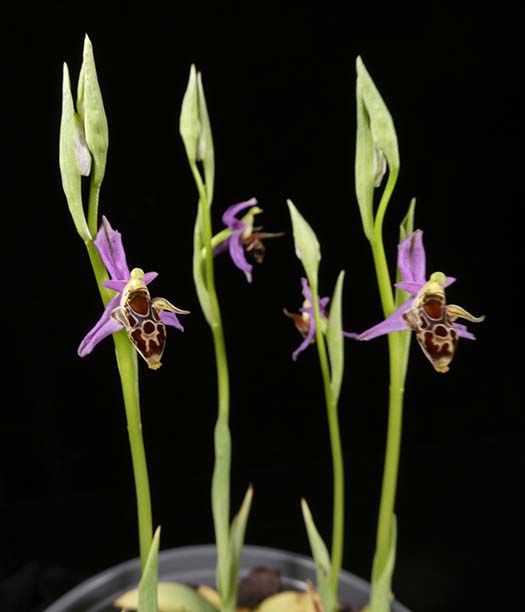 Ophrys cerastes
|
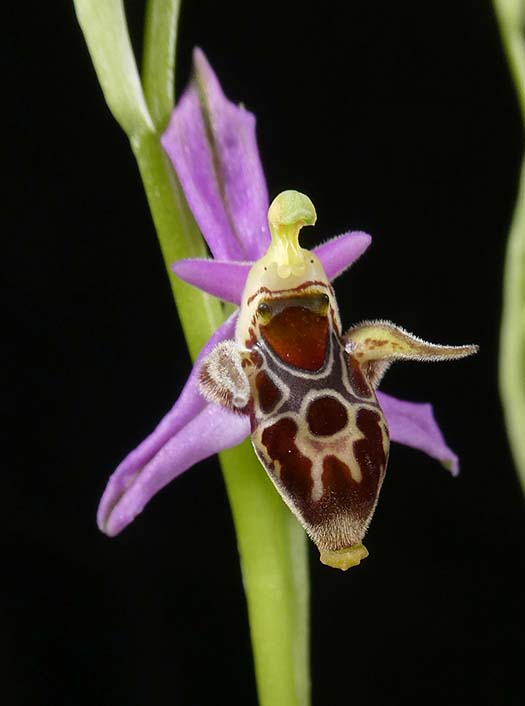 |
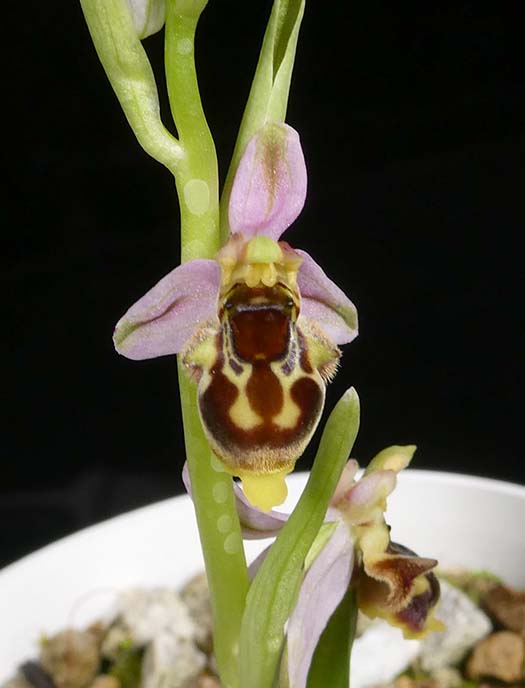 Ophrys hygrophila
|
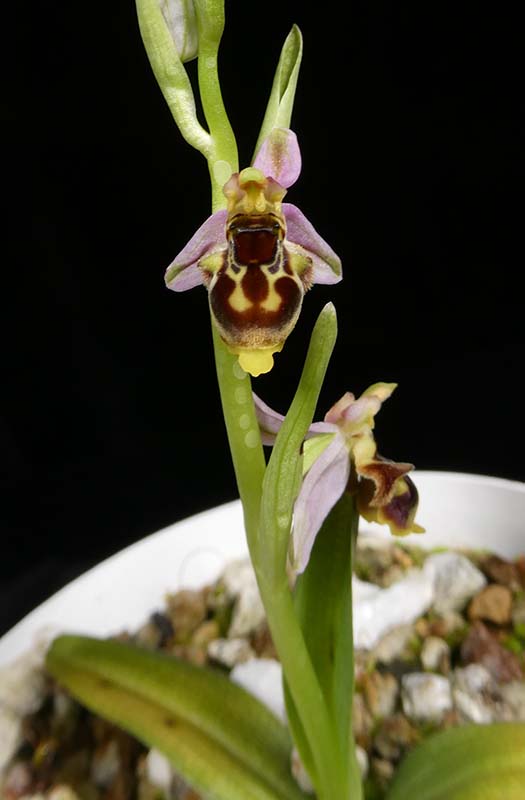 |
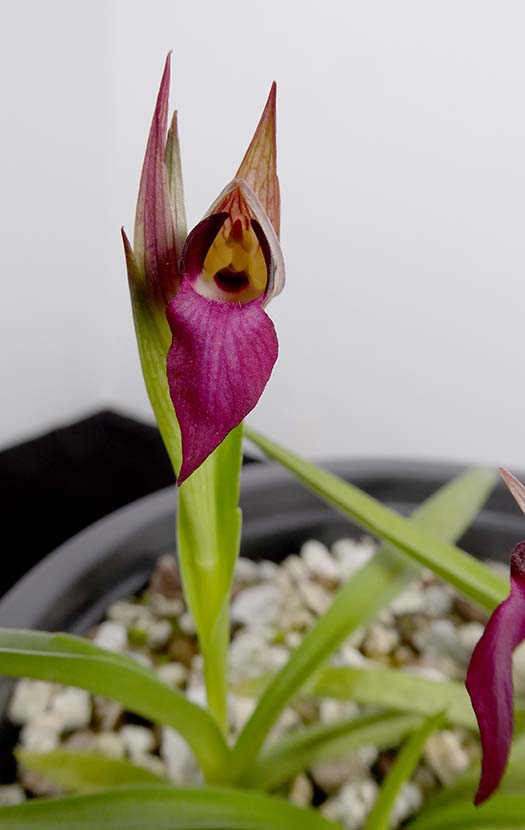
Serapias linguaThe "tongue orchid", native to Mediterranean Europe, North Africa, and as far north as the UK and France. There is considerable color variation within the species. As the tubers multiply, they form a nice clump. |
|
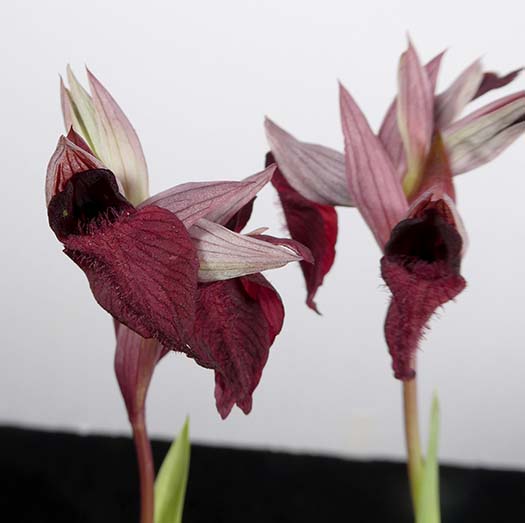
Serapias cordigeraDark, fuzzy beard-like lip. Stately flowers. |
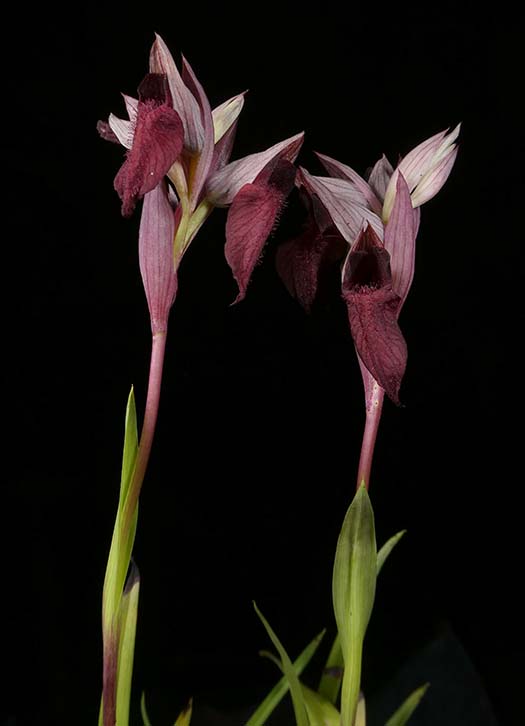 |
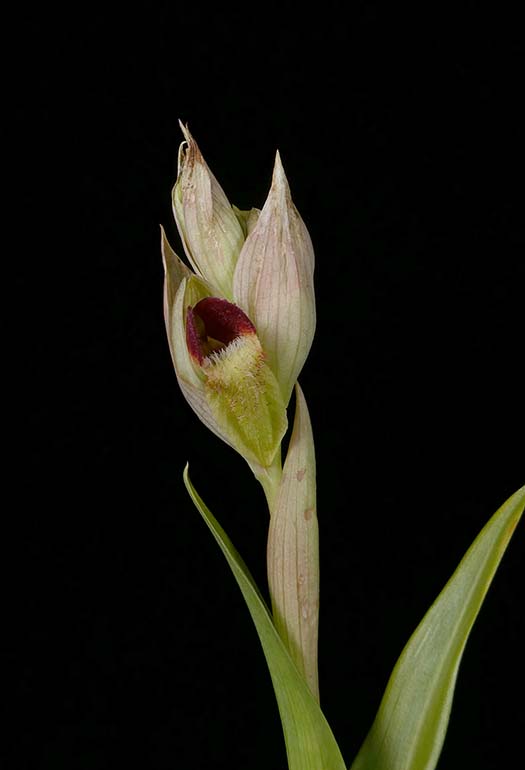 |
|
Serapias bergoniiA somewhat narrower range than its cousins, mostly eastern Mediterranean area. One of the larger species in the genus. |
|
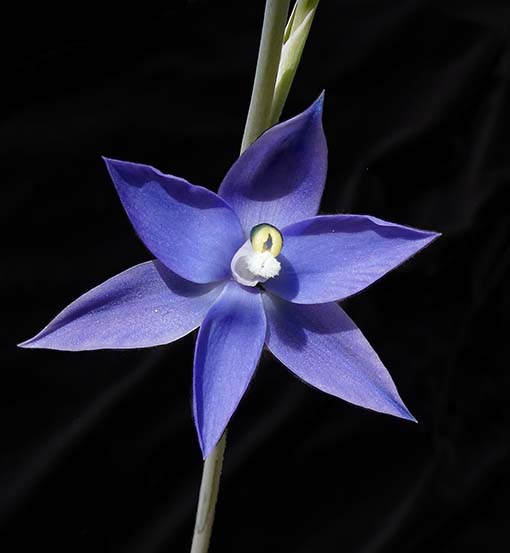 Thelymitra glaucophyllaBlue! From southern Australia. These are the "sun orchids". Thelys only open when there is bright sunshine, closing up on cloudy days. Recent bright days have brought out their beauty. Flowers are about an inch to 1.25 inches. |
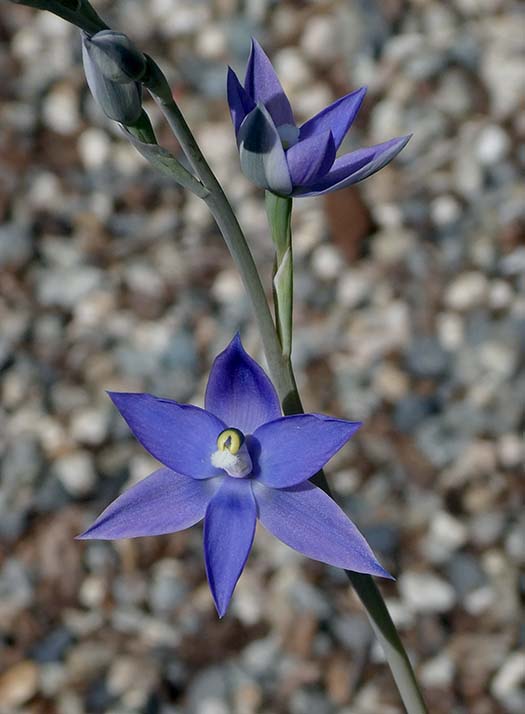 |
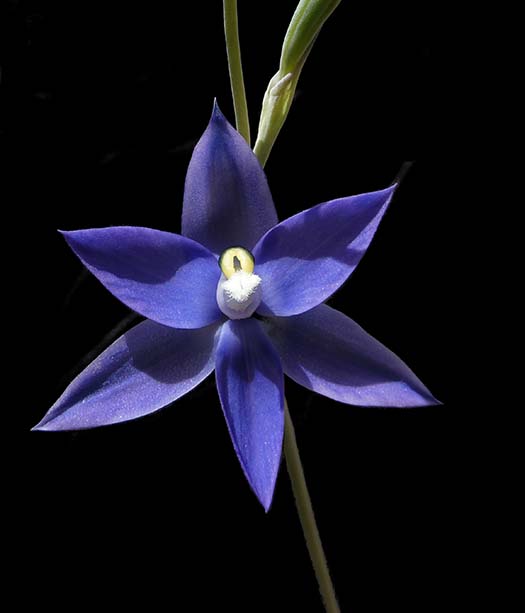 Thelymitra nudaA closely related species but Kew considers them separate. Native to south and southwest Australia, and Tasmania. The colors in the photos is pretty accurate. These were all photographed in natural sunlight. |
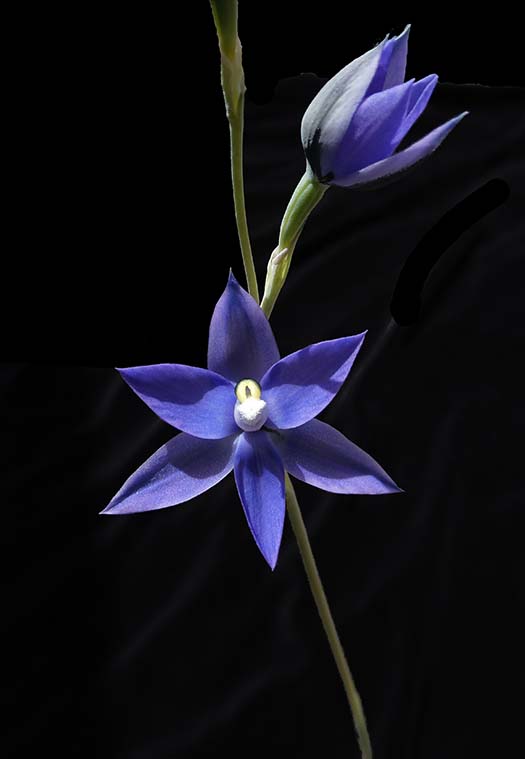 |
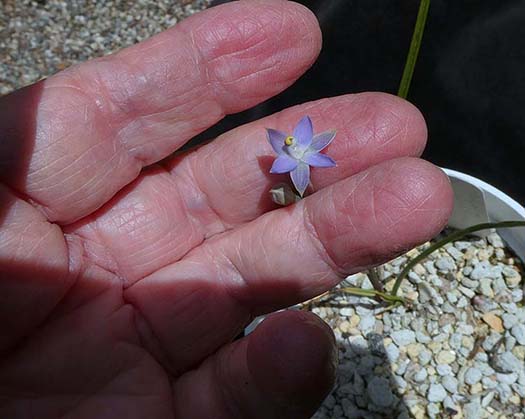 Thelymitra paucifloraThe little sister. Flower is barely 1/2 inch. Color not as saturated as glaucophylla and nuda but still very blue. And cute. South and southwest Australia and Tasmania |
|
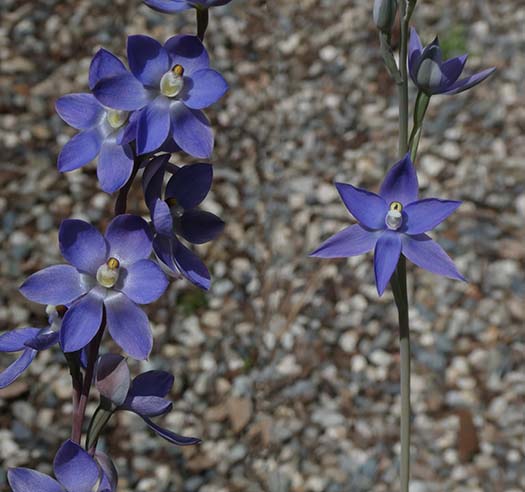 Thelymitra glaucophylla x grandiflora (left) and glaucophylla (right) above, and the primary hybrid with fingers for scale to the right.
|
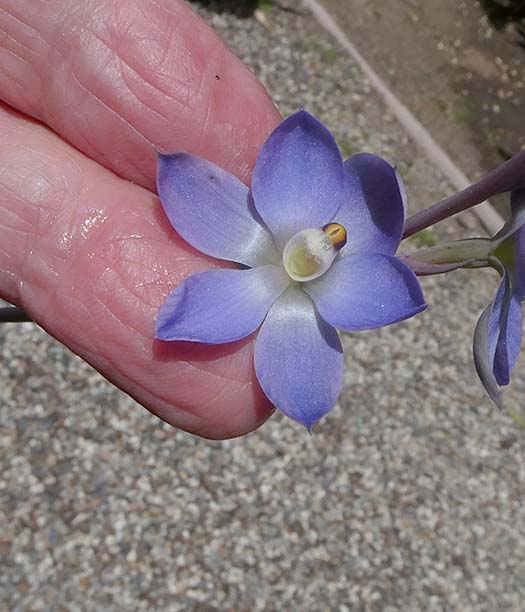 |
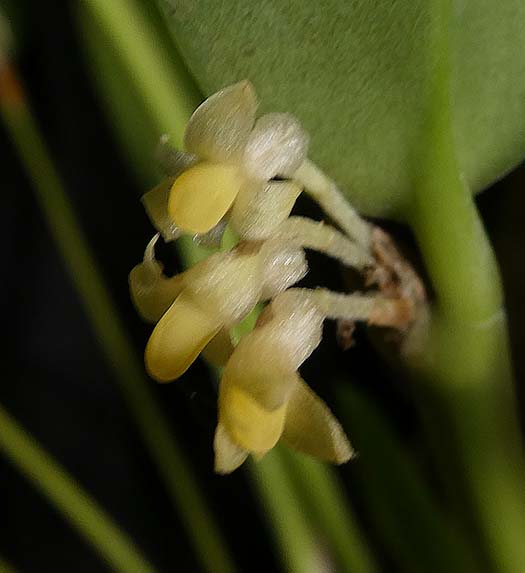 Ceratostylis sp. aff. backeriFlowers are only about 1/4 inch, but there are lots of them. From Java. |
|
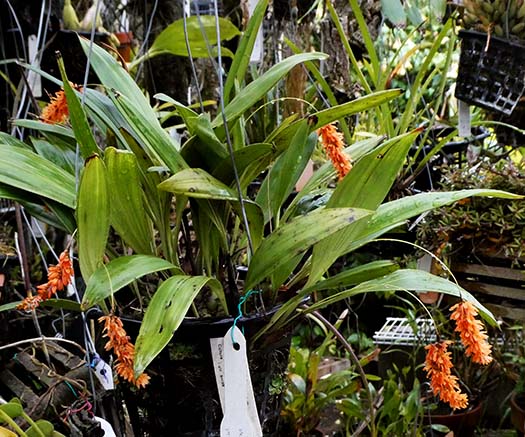
Dendrochilum coccineumFrom the Philippines, elevations above 1000 m. Flowers are relatively large for the genus. In the past, inflorescences opened one or two at a tme. This year it produced a nice flush bloom. |
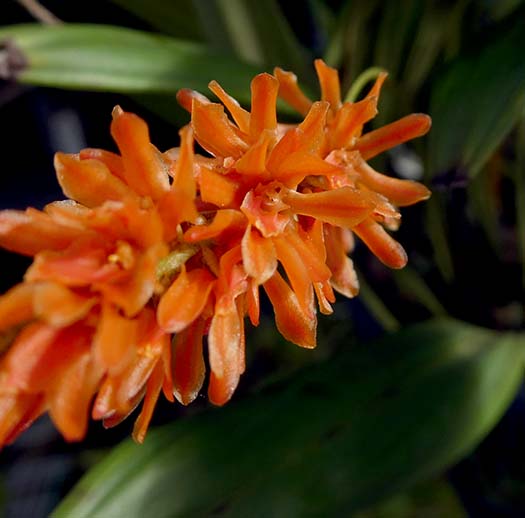 |
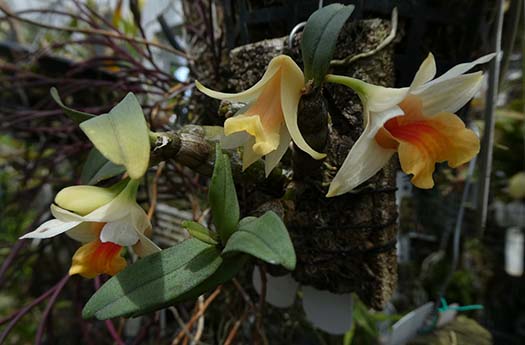 Dendrobium bellatulumNative to southeast Asia, south-central China, and eastern Himalaya. |
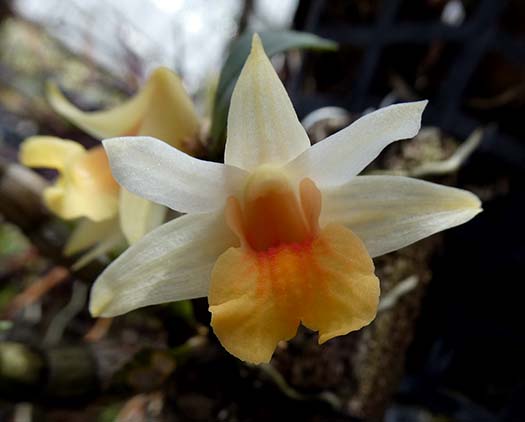 |
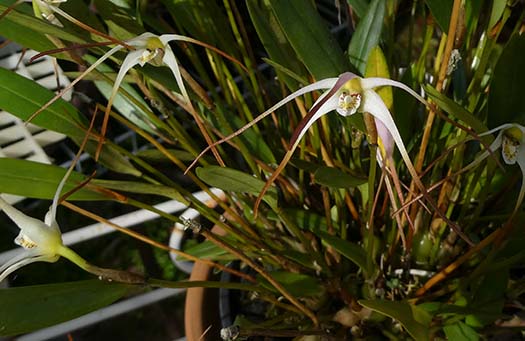 Diplocaulobium (Dendrobium) aratriferumFlowers last less than a day. Usually all the flowers open at once. This time, a few opened on one day, and then the rest the next day as the first few were fading. Flowers have the fragrance of watermelon. |
|
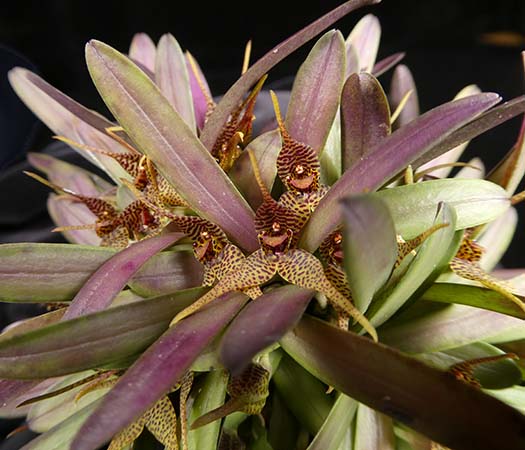
Dryadella zebrinaI remounted the plant last year and gave it a bit more room. It rewarded me with the best bloom so far, a ball of little flowers. Native to Brazil, Bolivia, and Peru at elevations 1500-3500 m. |
|
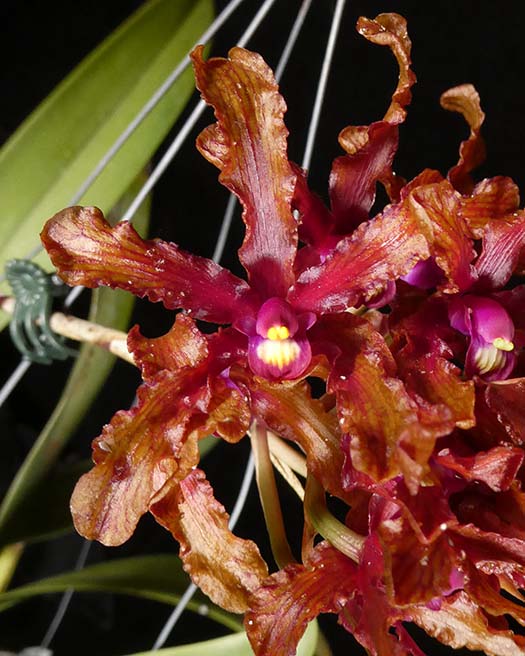 |
|
Laelia colombiana (Schomburgkia wallisii)Native to Colombia (of course) and Venezuela. |
|
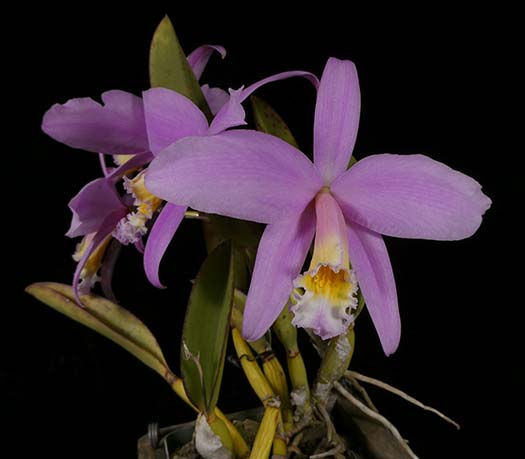
Cattleya (Laelia) jongheanaThe largest of the Hadrolaelias, with an outstanding flower-to-plant ratio. This one has 5.5 inch flowers on 6 inch growths (leaf plus pseudobulb). I have another cultivar, still a small division that only produced one flower, but that was a 6 inch flower on a 4 inch growth. Flowers are very flat (they almost seem to float), and long lasting (a month or more). The section includes others with flowers as big as the plant (such as C. pumila and C. sincorana) but much smaller, this one is very stately. Native to Minas Gerais state in Brazil, elevation 1300-1600 m. |
|
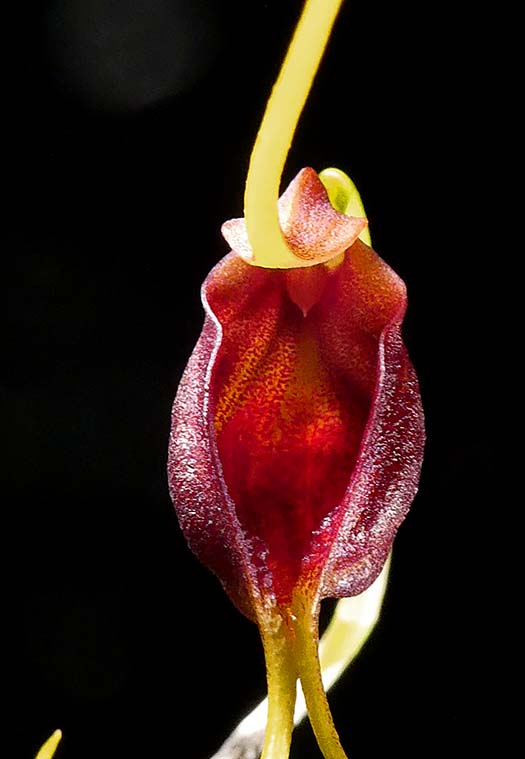
Masdevallia trochilusBlooms sequentially on an inflorescence, for a year or more. So don't cut the spikes until they are shriveled and brown. Native to Colombia, Ecuador, and Peru, elevation 1750-2200 m. |
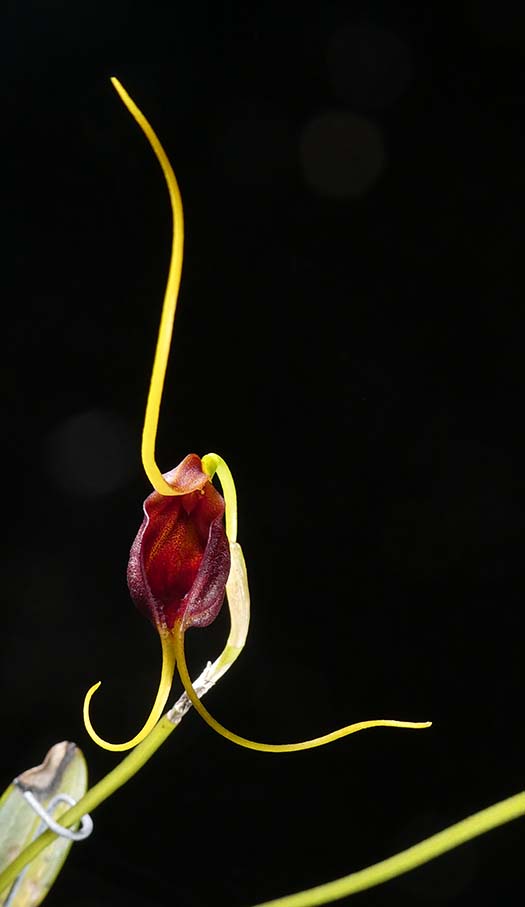 |
 1.jpg)
Maxillaria chrysantha (serotina)Native to southern Brazil and northeast Argentina, elevation around 1400 m. The buds are red with stripes, that that coloration shows on the backs of the sepals, while the front is golden yellow. |
|
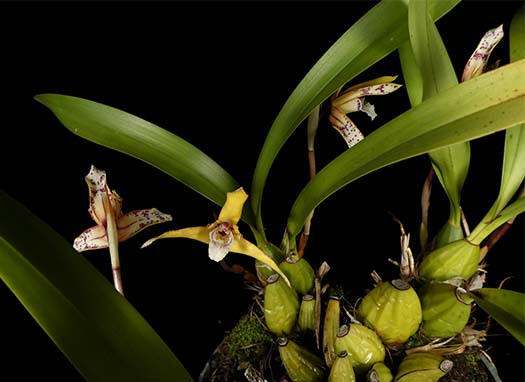
Maxillaria pictaClosely related to Max chrysantha. It's very common in cultivation in southern California, growing very easily. The buds (and backs of the sepals) have burgundy spots on a cream-white background. The flowers are very fragrant, reminiscent of vanilla. |
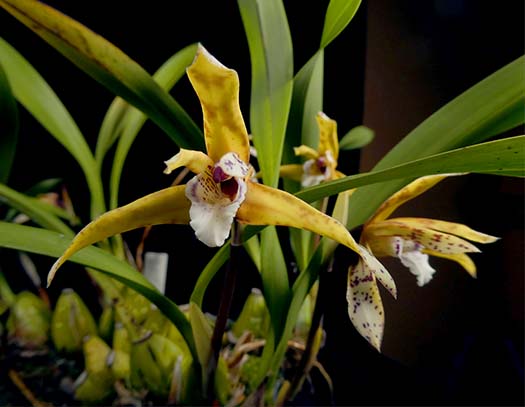 |
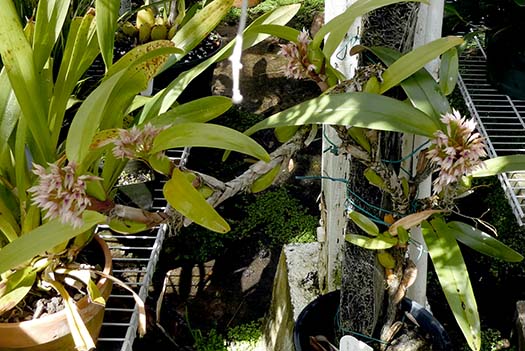
Maxillaria densaThis one produces new pseudobulbs along an ever-lengthening stem. Don't try to "clean up" the papery coating between the pseudobulbs, or you risk killing the plant because those bracts protect roots that run all the way down to the base of the plant. Flowers are delicate in color and small in size, but there are lots of them. Native to Mexico and much of Central America, from sea level to 1400 m. Because the plant is very top-heavy, I tie it to one of the supports of the patio cover. It is tied to a hapu'u pole that goes into the pot, but it has long since grown beyond that. |
|
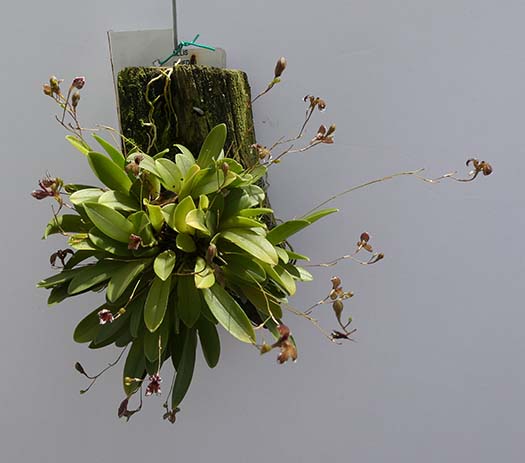
Pleurothallis ornataThe fringes on the tiny flowers wave in the breeze. This is the best flush bloom, it clearly liked our rainy, cool winter. This has been confused with Pths. scheidei, which is actually a different plant. Notes from IOSPE . (Note the photo and its photographer in the link... a perfect presentation!) |
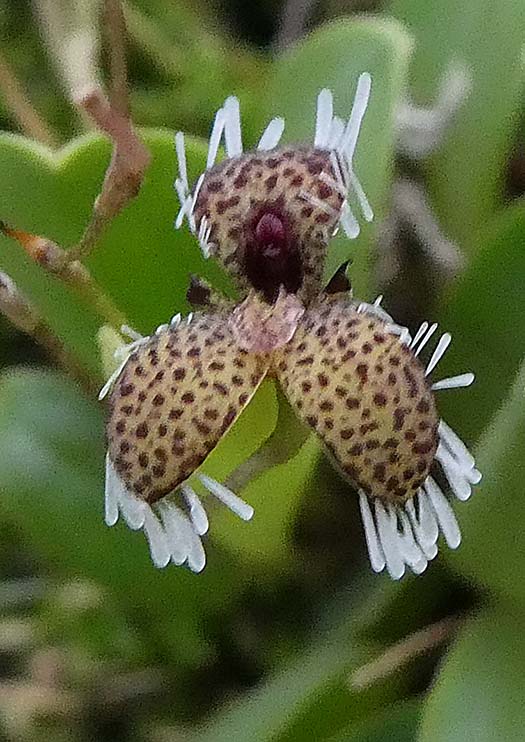 |
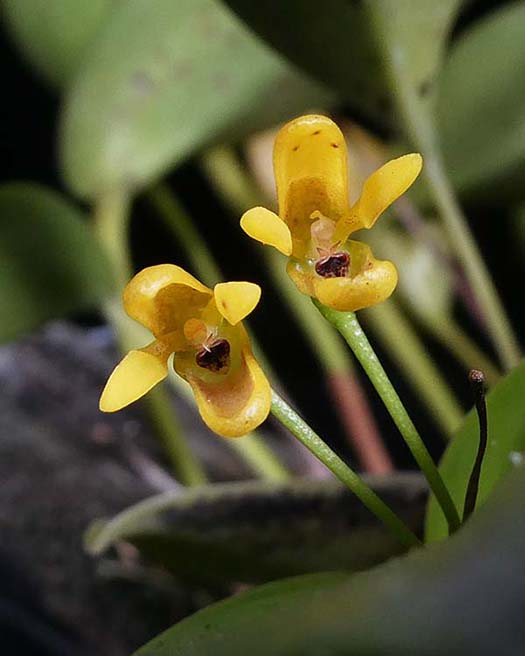 |
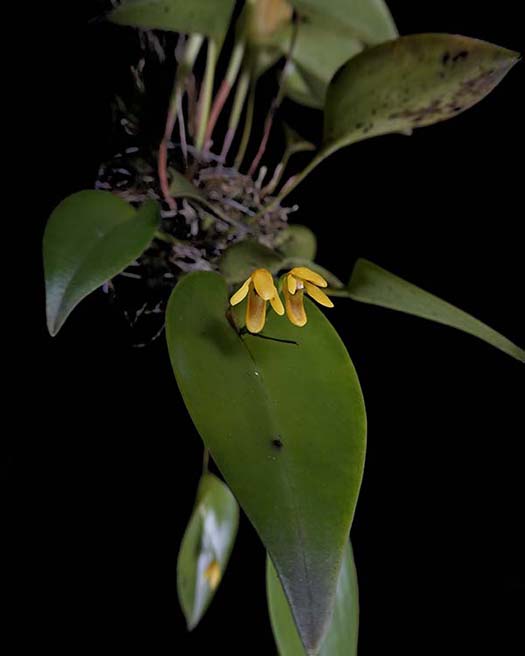 |
Pleurothallis recurvataNative to Ecuador, 750-1200 m. |
|
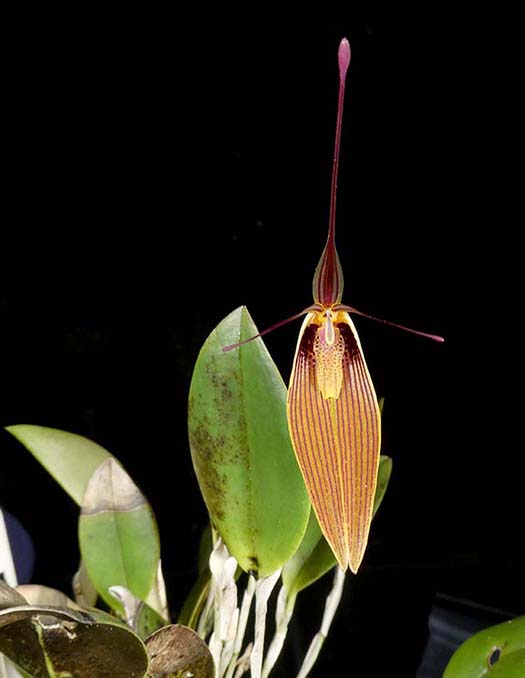 |
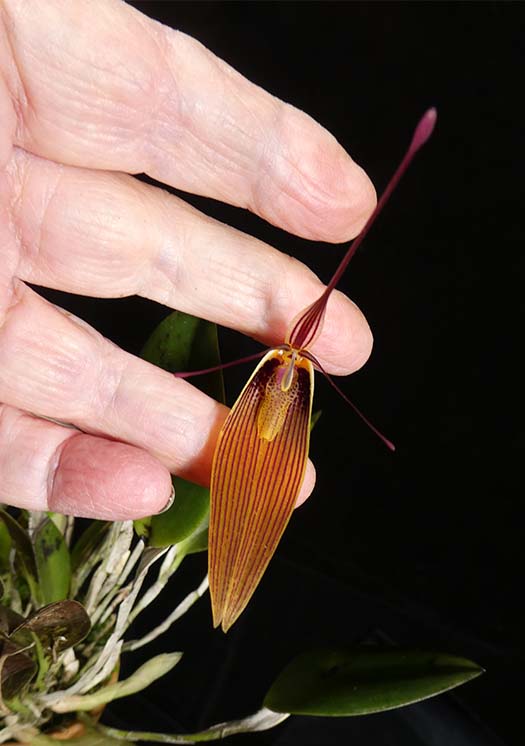 |
Restrepia antennifera 'Cow Hollow'This flower is huge for the genus. Native to Venezuela, Ecuador, Colombia, elevation 1700-3500 m. |
|
In the greenhouse... |
|
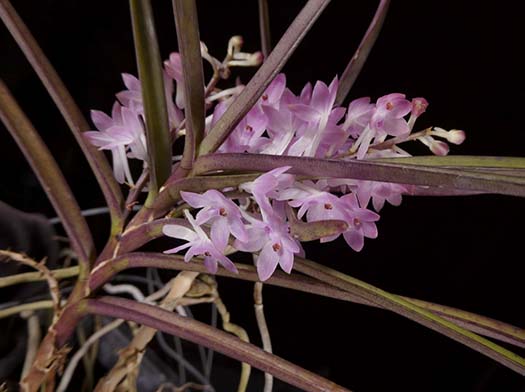
Ascocentrum christensonianum
|
|
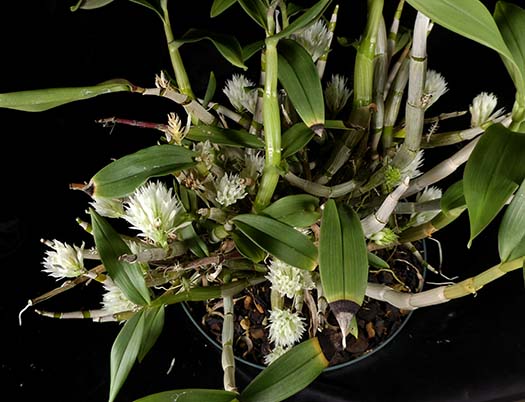 Dendrobium capituliflorumNative to New Guinea, below 600 m. The plant is very vigorous, produce many of these "pom-pom' clusters of flowers. It can bloom repeadedly on a cane. |
|
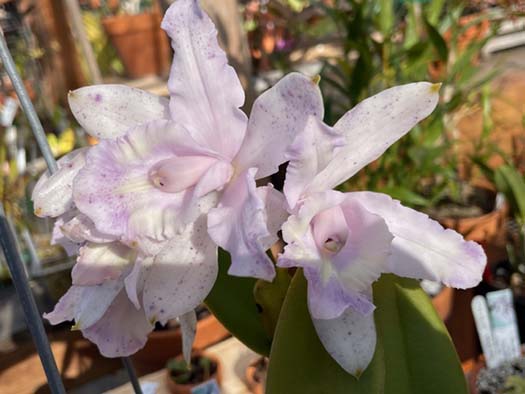
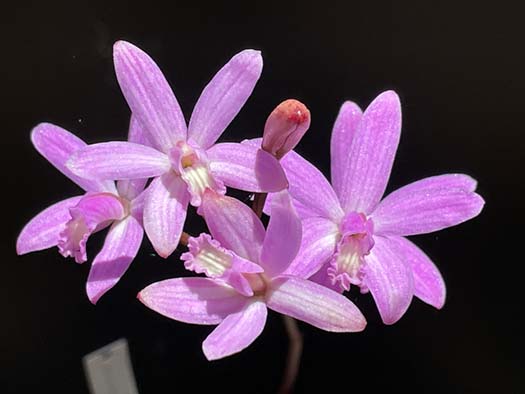
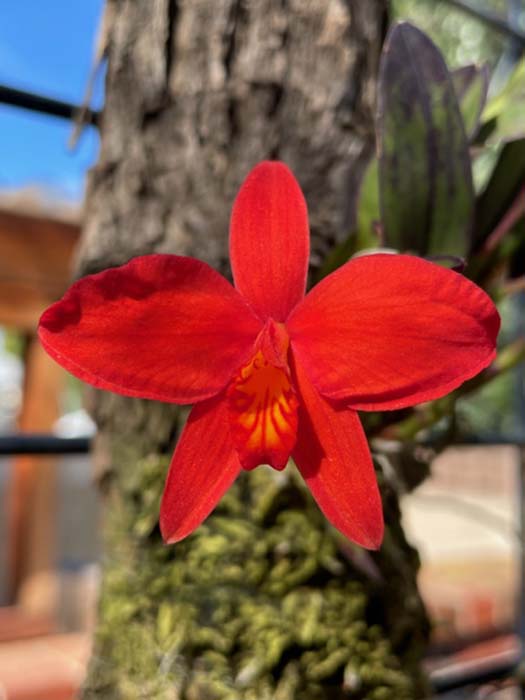
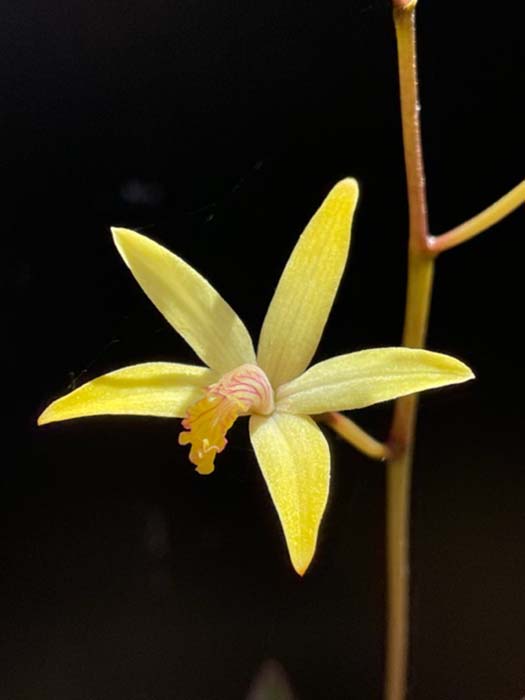
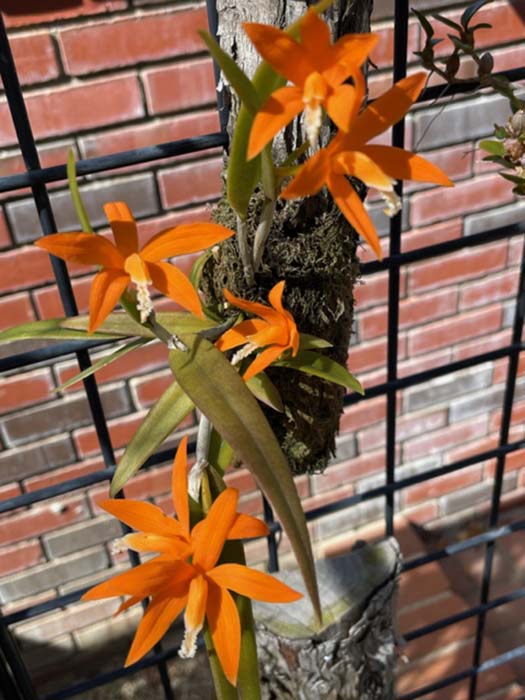
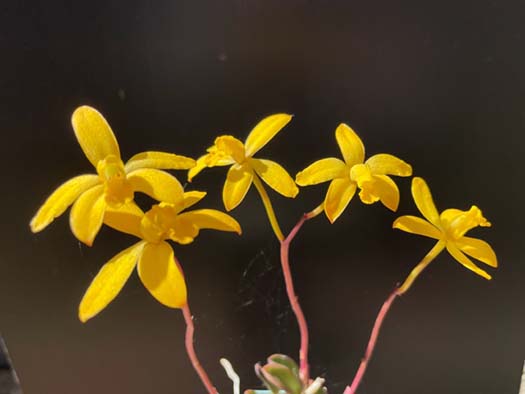
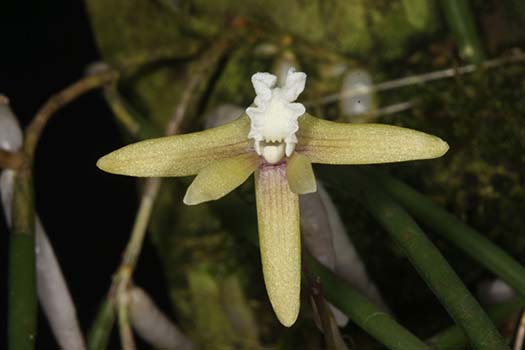
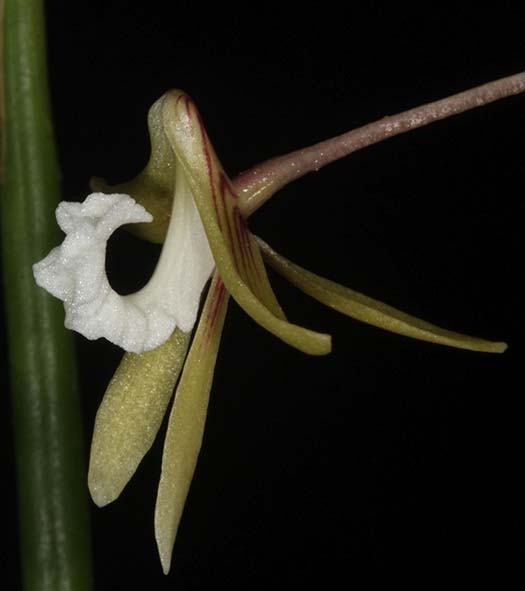
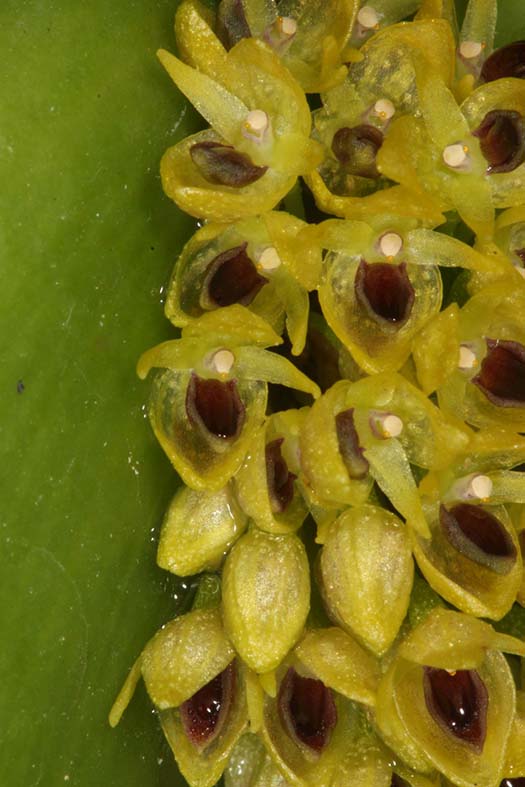
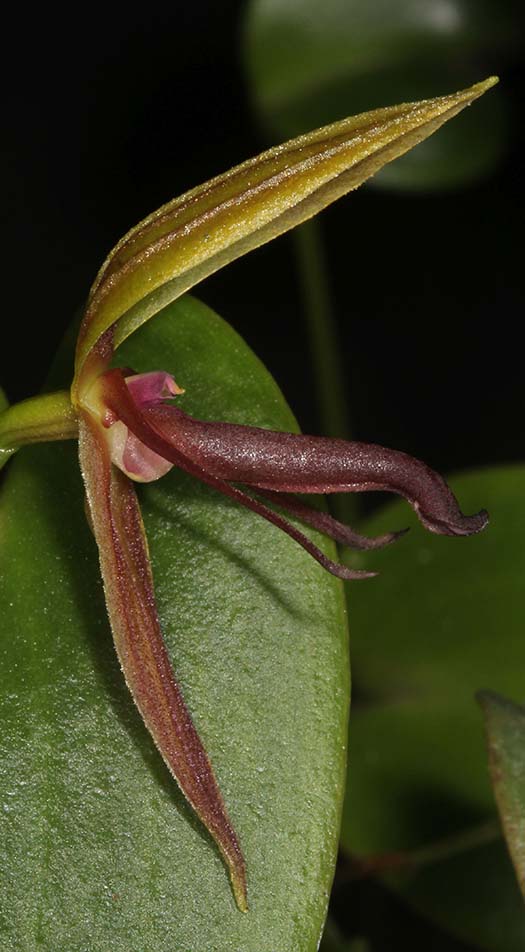
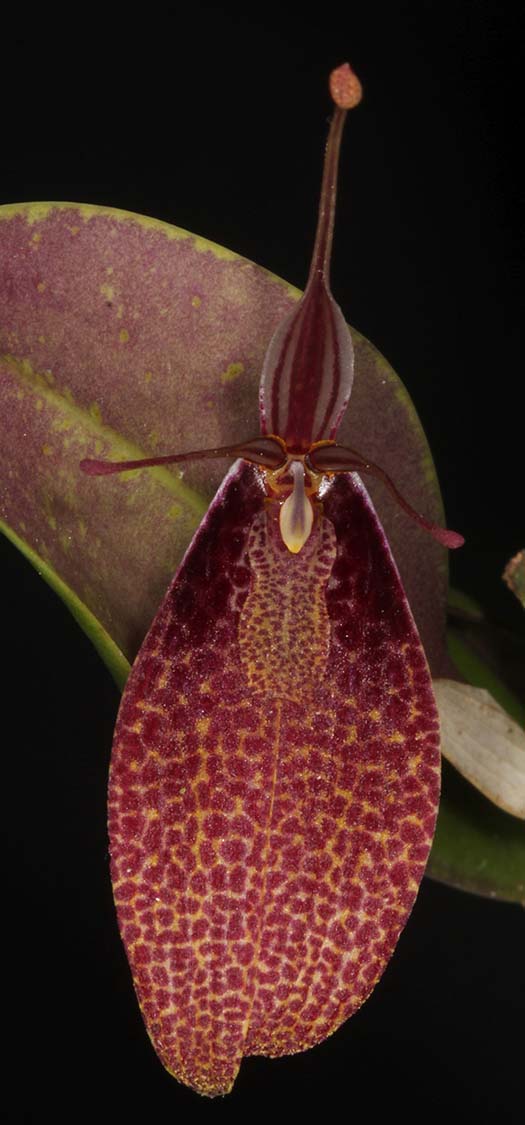
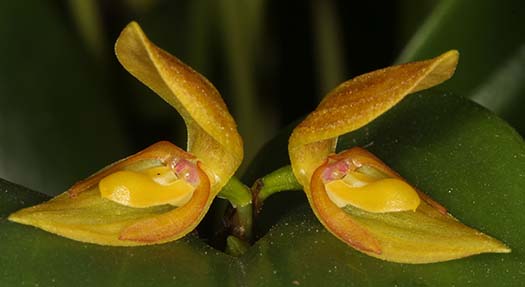
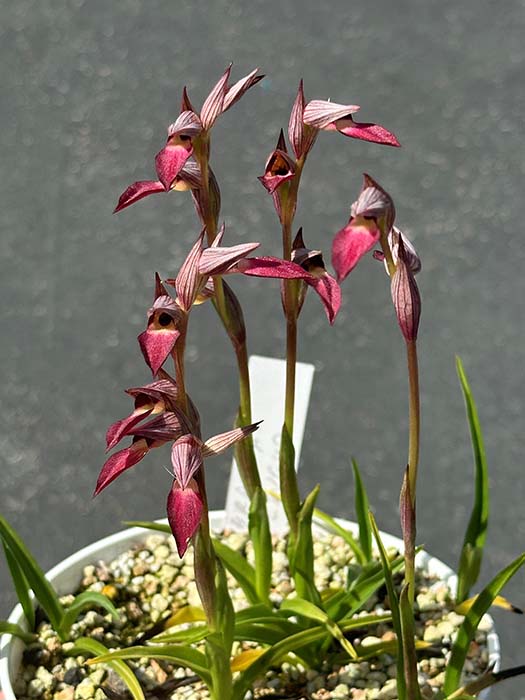
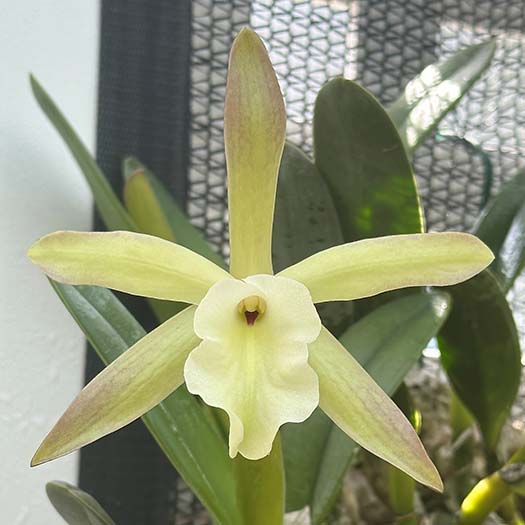
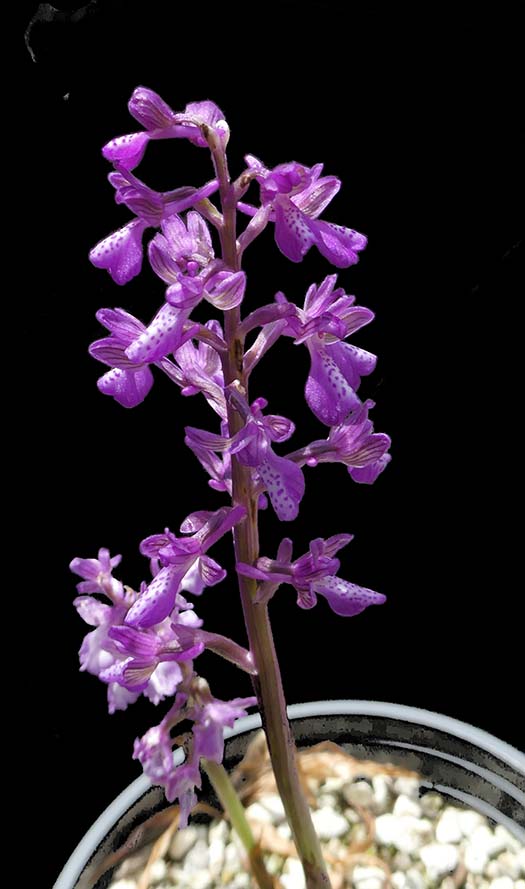
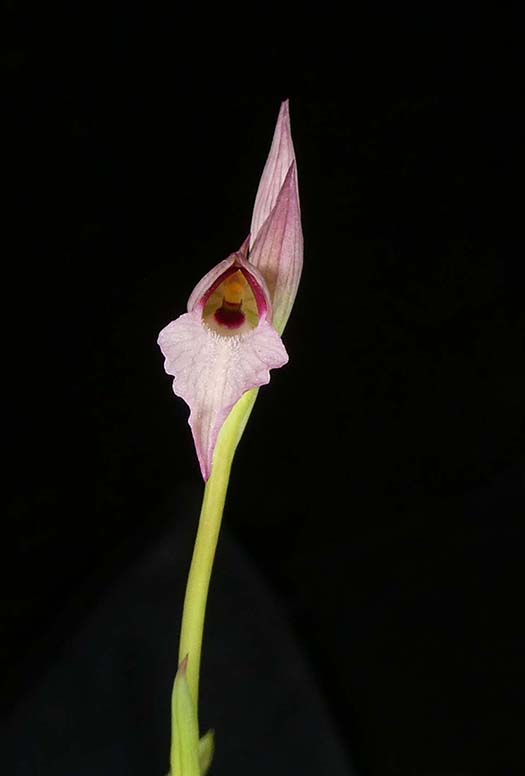
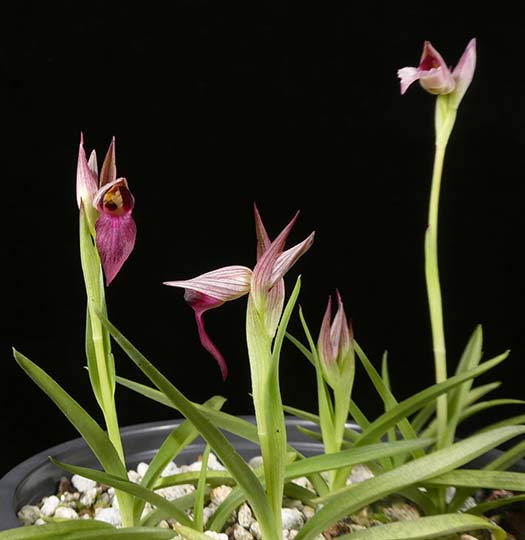
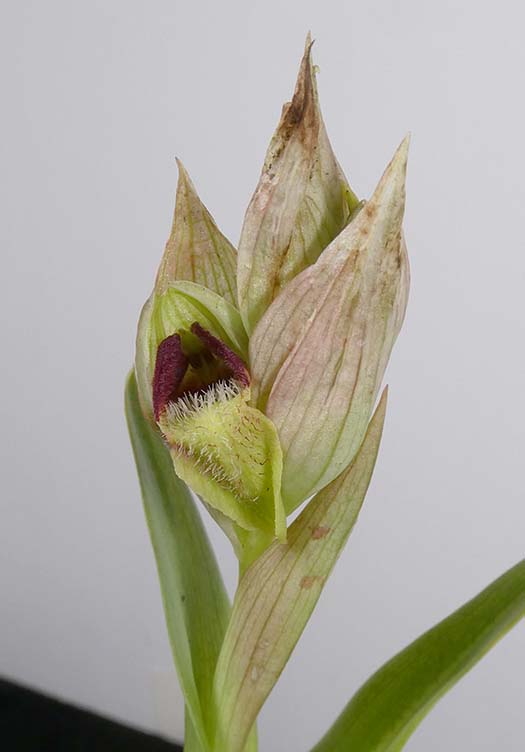
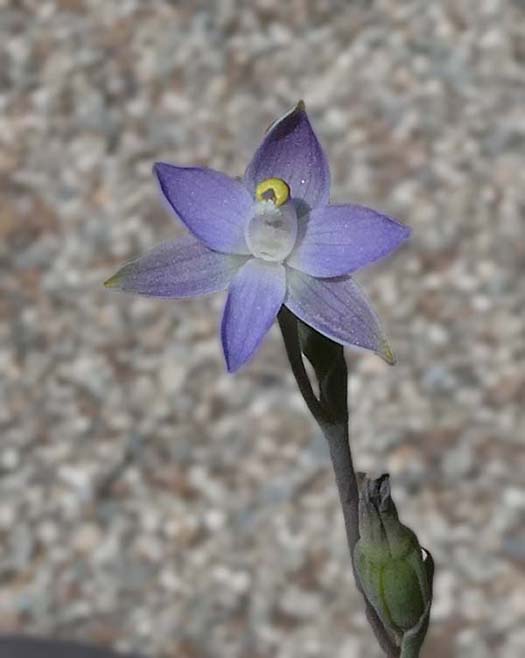
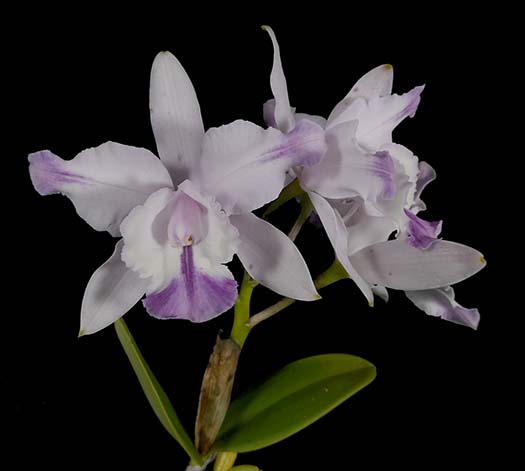
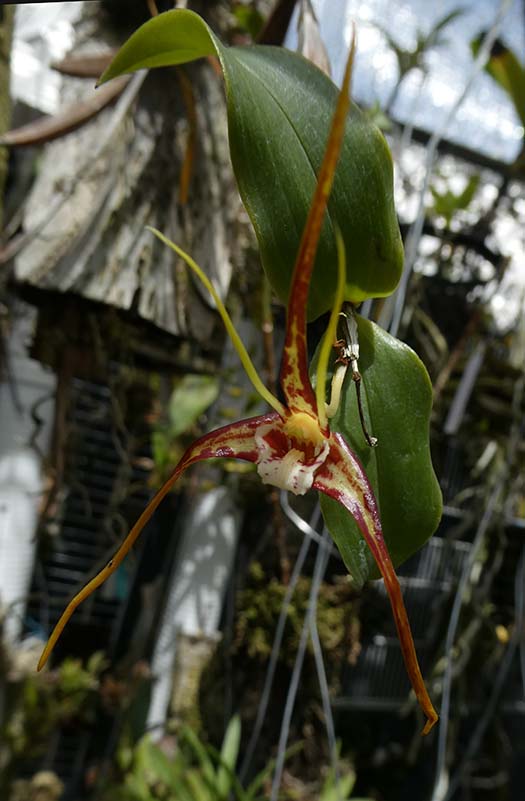
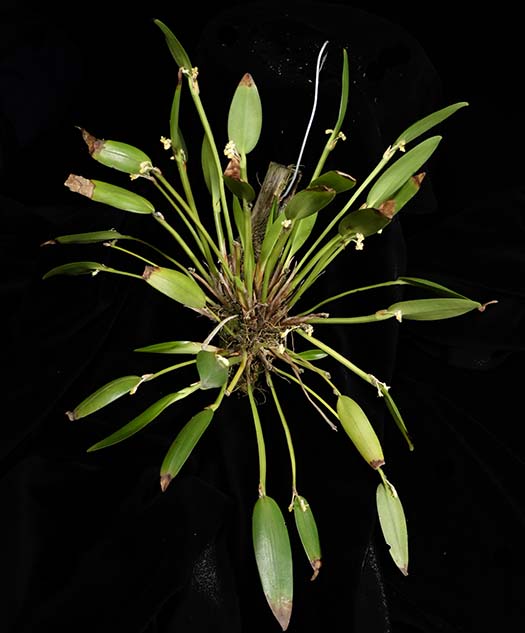
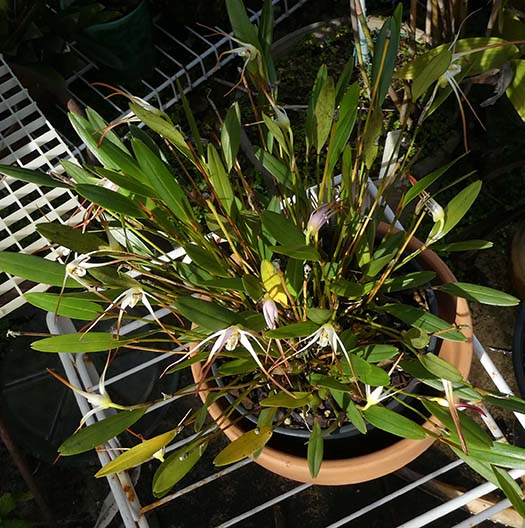
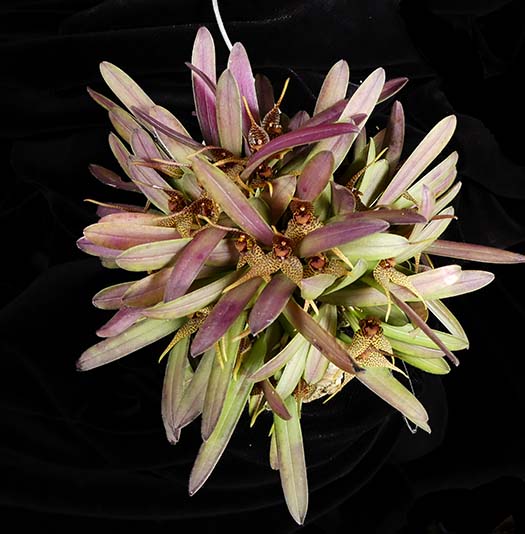
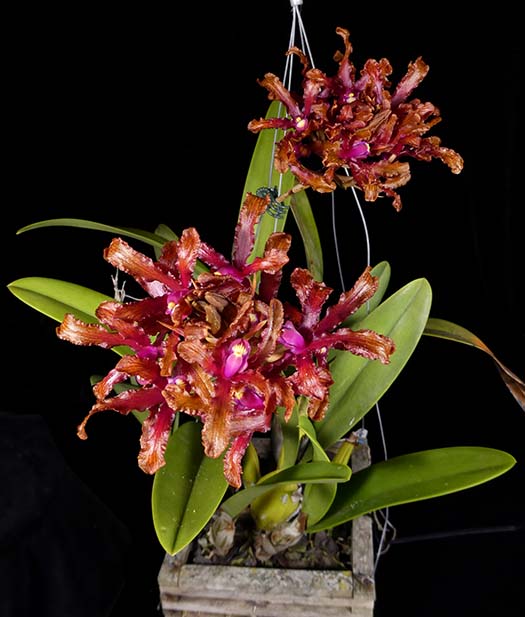
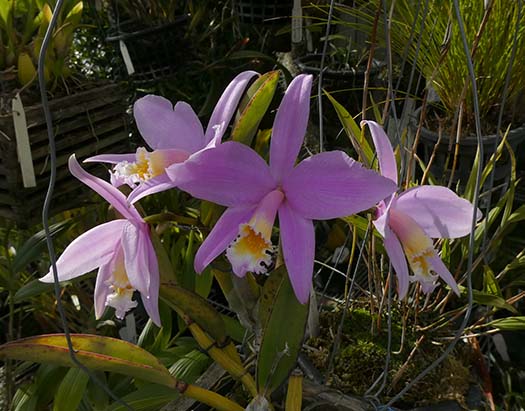
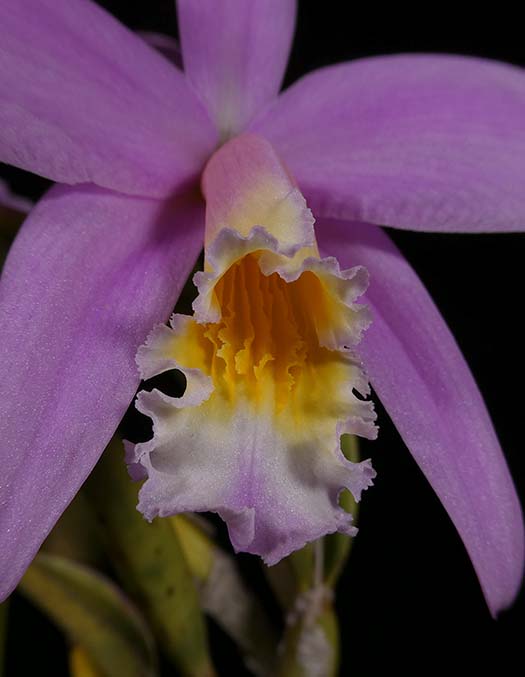
 2.jpg)
